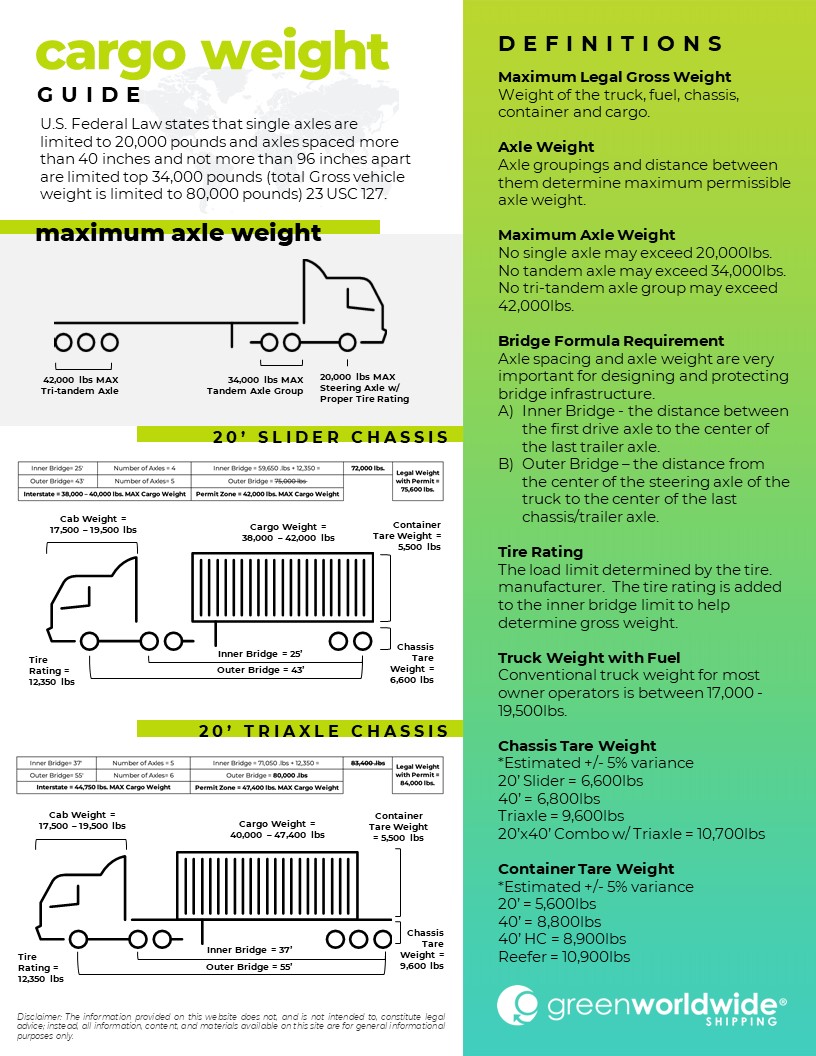In the United States, there are defined guidelines for both local and Interstate highway systems that regulate how much weight any set of axles on a motor vehicle may carry.
U.S. Federal Law states that single axles are limited to 20,000 pounds and axles spaced more than 40 inches and not more than 96 inches apart are limited to 34,000 pounds (total Gross vehicle weight is limited to 80,000 pounds) 23 USC 127.
Trucking companies must comply with rules, such as the Bridge Formula, to ensure the infrastructure can handle the capacity and equipment without damage. Just because product(s) can be dimensionally fit into a shipping container, does not mean the weight will be road-legal to move without transloading in the United States.
BACKGROUND
Congress enacted the Bridge Formula in 1975 to limit the weight-to-length ratio of a vehicle crossing a bridge. This is accomplished either by spreading weight over additional axles or by increasing the distance between axles. Axle spacing and axle weight are very important for designing and protecting bridge infrastructure.
BRIDGE FORMULA

W = the overall gross weight on any group of two or more consecutive axles to the nearest 500 pounds
L = the distance in feet between the outer axles of any group of two or more consecutive axles
N = the number of axles in the group under consideration
20’ CONTAINER WEIGHING 38,500 LBS
For a standard 20’ container, depending on the weight of the vehicle and chassis and in order to satisfy the Bridge Formula, special equipment, such as tri-axles, and permits must be used to accommodate overweight cargo.
In most states, shipments can be classified as ‘heavy’ when cargo exceeds:
- 20 ft dry container that has a cargo weight above 37,500 pounds (with some exceptions)
- 40 ft dry or High Cube container that has a cargo weight above 43,500 pounds (with some exceptions)
OVERWEIGHT PERMITS
Not all states allow overweight permits, some requiring all overweight cargo to be broken down into smaller shipments or require applying on a case-by-case basis.
Did you know: Over 50% of all U.S. trucking citations issued are for axle weight violations and is usually the result of uneven distribution of the load inside the container.
For more detailed information, visit the U.S. DOT Federal Highway Administration’s Federal Bridge Formula Guide at
https://ops.fhwa.dot.gov/freight/publications/brdg_frm_wghts/fhwahop19028.pdf
Disclaimer: The information provided on this website does not, and is not intended to, constitute legal advice; instead, all information, content, and materials available on this site are for general informational purposes only.
Stay up-to-date on freight news by following us on Facebook, Twitter, and LinkedIn, and make sure to check out our website at greenworldwide.com.







